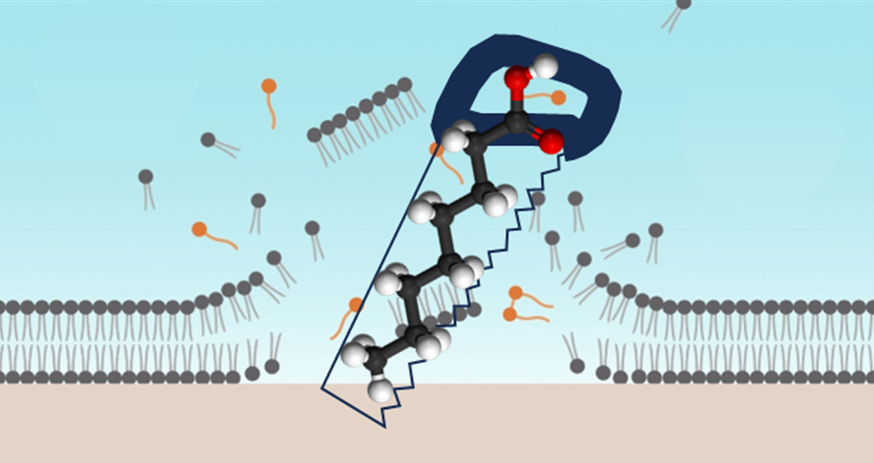The ancient art of soap making
For thousands of years, humans have used soaps to clean and disinfect. In fact, the oldest documented soap-making process – dating back 5000 years in ancient Babylonia – involved boiling animal or plant fats with ash. Scientifically speaking, this meant breaking down triglycerides into fatty acids. These fatty acids possess both hydrophilic (water-loving) and hydrophobic (water- fearing) properties. And the unique combination of properties turns the fatty acids into ‘detergents’: agents that can make greasy elements soluble.

Antimicrobial properties
Soap’s detergent properties extend far beyond cleaning. This is because many microbes, including bacteria and viruses, are surrounded by a membrane made of lipids. Detergents (read: fatty acids) can tear these membranes apart and subsequently kill the microbes. It’s no wonder that surgeons scrub their hands with soap to prevent infections in surgery rooms. Our bodies use this very same mechanism as a natural means of self-protection as well: our skin contains antimicrobial fatty acids at concentrations that are lethal to certain pathogens. Remarkably, even after 5000 years, microbes have still not developed resistance to the effects of fatty acids, which accounts for their enduring efficacy.
Medium-chain fatty acids: nature’s detergent
Through the centuries, we’ve perfected our understanding of fatty acids’ antimicrobial properties. We now know, for instance, that medium-chain fatty acids (MCFAs) are a particularly important category of lipids. Containing 6 to 12 carbon atoms, MCFAs strike the perfect balance between hydrophilicity and hydro- phobicity to result in highly effective microbial membrane disruption. Acting like a saw, they penetrate and rupture microbial membranes, effectively neutralizing pathogens.

MCFAs in animal health: pathogen control
Advances in MCFA research have led to tailored blends optimized to combat specific types of bacteria and to work under different environmental conditions. On top of this, we have learned how to make blends that don’t taste like soap, so that they can be added to animal feed without affecting the feed intake. When added to animal feed, MCFA blends serve a dual purpose: disinfecting the feed and improving intestinal health.
Studies
- Research from Kansas State University (Aldrich et al., 2019) has shown that MCFAs (especially MCFAs that are on the shorter side) can swiftly move around in the feed and kill salmonella bacteria. In the study, the diets’ salmonella counts dropped from 100,000 bacteria per ml to undetectable within 4 hours after production of the feed.
- Research from Pipestone Research, South Dakota State, and Kansas State has shown that the addition of MCFA blends to animal feed can reduce the risk of the animals becoming sick due to feed contamination with PEDv, PRRSv, SVA.
- Other studies demonstrate MCFAs’ ability to reduce pathogen counts in the intestinal tract, particularly in acidic environments like the stomach. Even at low concentrations, MCFA can reduce the count of pathogens like E. coli, Strep. suis, Salmonella, Staphylococcus, and Actinobacillus (previously called Haemophilus).
MCFAs in animal health: immune support
More recent scientific findings reveal MCFA’s interaction with the immune system, activating specific membrane receptors such as GPR84. This activation triggers immune responses such as chemotaxis, phagocytosis, and cytokine secretion, which enhance the body’s ability to combat infections.
Research trials with MCFA-fed animals, performed by Crowder at Purdue University and PMI additives, demonstrate increased resilience against a range of pathogens, including viruses like PRRSv and bacteria like Strep. Suis:
Studies
- PRRSv viral copies were nearly 70% lower, resulting in strongly reduced disease symptoms, including an 80% reduction in lung lesions.
- Strep. suis prevalence was also reduced by 40%, as were other opportunistic pathogens (Mycoplasma by 48%,
- Pasteurella by 80%, Staphylococcus by 90 %).
- Interestingly, Lactobacilli – a bacterium typically deemed beneficial for animal health – increased by 60%.
Field observations with natural PRRSv infections corroborated these findings (Tran et al., 2023).
Evolution of fatty acids technology
Over thousands of years now, mankind’s knowledge has evolved from making soap out of crude fat sources to developing sophisticated fatty acid blends targeted at specific pathogens and immune system support. Today, these advances yield products that effectively decontaminate feed, improve intestinal health, and boost immune function – enhancing their relevance in animal health management on into the future.